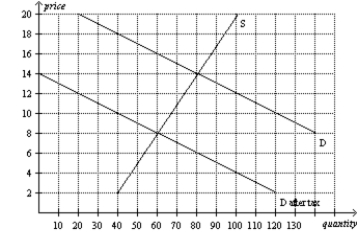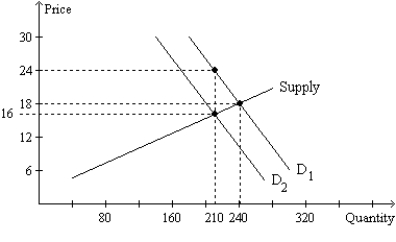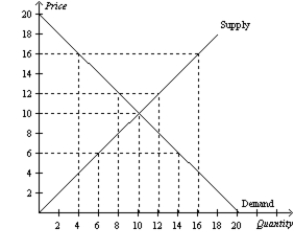A) decreases a binding price floor in that market.
B) increases a binding price ceiling in that market.
C) increases a tax on the good sold in that market.
D) imposes a binding price ceiling in that market.
F) A) and C)
Correct Answer

verified
Correct Answer
verified
Multiple Choice
Figure 6-26  -Refer to Figure 6-26. The price paid by buyers after the tax is imposed is
-Refer to Figure 6-26. The price paid by buyers after the tax is imposed is
A) $16.
B) $8.
C) $14.
D) $12.
F) B) and C)
Correct Answer

verified
Correct Answer
verified
Multiple Choice
Figure 6-24  -Refer to Figure 6-24. In the after-tax equilibrium, government collects
-Refer to Figure 6-24. In the after-tax equilibrium, government collects
A) $1,440 in tax revenue; of this amount, $960 represents a burden on buyers and $480 represents a burden on sellers.
B) $1,440 in tax revenue; of this amount, $720 represents a burden on buyers and $720 represents a burden on sellers.
C) $1,680 in tax revenue; of this amount, $1,260 represents a burden on buyers and $420 represents a burden on sellers.
D) $1,680 in tax revenue; of this amount, $840 represents a burden on buyers and $840 represents a burden on sellers.
F) A) and D)
Correct Answer

verified
Correct Answer
verified
Multiple Choice
Figure 6-4  -Refer to Figure 6-4. A government-imposed price of $6 in this market is an example of a
-Refer to Figure 6-4. A government-imposed price of $6 in this market is an example of a
A) binding price ceiling that creates a shortage.
B) non-binding price ceiling that creates a shortage.
C) binding price floor that creates a surplus.
D) non-binding price floor that creates a surplus.
F) None of the above
Correct Answer

verified
Correct Answer
verified
Showing 641 - 644 of 644
Related Exams